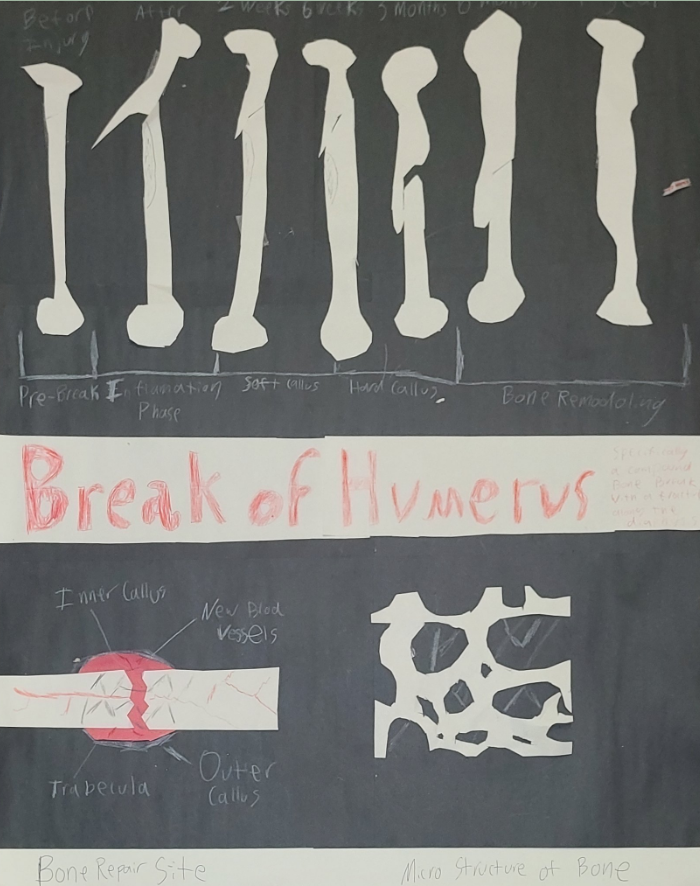

2. Pfeiffenberger, M., Damerau, A., Lang, A., Buttgereit, F., Hoff, P., & Gaber, T. (2021). Fracture Healing Research-Shift towards In Vitro Modeling?. Biomedicines, 9(7), 748. https://doi.org/10.3390/biomedicines9070748
3. Mostafa, E., & Varacallo, M. (2018, December 3). Anatomy, Shoulder and Upper Limb, Humerus. Nih.gov; StatPearls Publishing. https://www.ncbi.nlm.nih.gov/books/NBK534821/
The objective I covered was “Know the stages of bone development and repair” focused on the latter part. It just shows the stages using cut and torn paper adding a human touch as well as a zoomed in part. Slightly abstract. I also used a black contrast to make it more contrasting. It was put together with double sided tape as opposed to glue as I think it makes less bubbles in the paper. Bone healing is a complex process. Beginning with hematoma the blood repairs structure. I had a compound fracture shown which is on the worse end. Bone morphogenetic proteins will be produced to begin the repair process. The bone can heal even rather bad fractures as I showed without surgery. Growth factors will be produced making more osteoblasts. Bone healing is seen as going through 4 stages. Formation of the hematoma, fibrocartilaginous callus formation, bone callus formed, and finally bone repair and remodeling. Parathyroid Gland among others will secrete these hormones. The healing of the bone may progress in different ways depending on how much strain is on it during dealing. Too much strain stops healing while no strain signals healing should stop forming an S curve. Strain will peak in the middle of bone repair as the body is healing at full ability before slower repair teeters down to nothing. A feedback loop will be produced with more callus being formed causing more tissue formation which is then checked by the body. This ramps up or down healing depending on the amount of damage president at a time. Cartilage will be the main structure turning to woven bone. Woven bone will change to lamellar bone. This will mean the rather aimless structure of woven bone will be transformed into more regular and stronger sheets. Collagen will play a big role in this structure. This will return the body to homeostasis. The stimulation from swelling or callus formation may play a role in signaling healing but it is believed to be primarily chemical in nature. Bone is not all that matters. Angiogenesis will occur leading to new formation of blood vessels both to replace damaged ones and bring in higher levels of oxygen for high demanding healing reactions. In the clinical context the cast remains important as it reduces strain and damage. Doctors should consider the type of fracture when setting up support. Asymmetrical geometries of fracture likewise are best supported asymmetrically returning the bone to its normal distribution of pressure. Surgical screws can be put in a heavily broken bone to add in healing. They provide more structure than the normal callus could and prevent the body from remodeling into something undesirable in shape. These will be best used on large long weight bearing bones such as the femur or humerus. A full theory of bone healing remains elusive such as an incomplete understanding of the mechanical factors, early stage, and the exact reasons for the progression of remodeling. Further studies into this will be needed as well as better data analysis by new tools such as artificial intelligence.